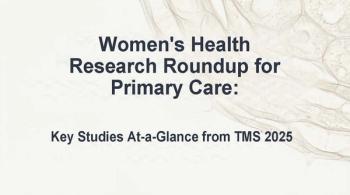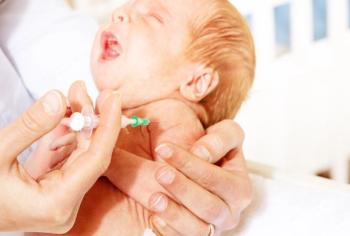
Heavy Smoking Compromises Uterine Receptiveness in IVF
VALENCIA, Spain -- Heavy cigarette smoking damages the uterine lining, reducing the likelihood of implantation even with donated oocytes in IVF procedures, researchers here reported.
VALENCIA, Spain, Nov. 9 -- Heavy cigarette smoking damages the uterine lining, reducing the likelihood of implantation even with donated oocytes in IVF procedures, according to researchers here and Lisbon.
In a retrospective study of the effect of smoking on uterine receptiveness to an implanted donor egg, non-smokers and light smokers had approximately 18% higher implantation rates than heavy smokers, said Sergio Soares, M.D., of IVI Lisboa in Lisbon, and researchers at the University of Valencia.
The negative impact of smoking on fertility and ovarian response has long been clear, but the researchers said this was the first study of smoking's effect on the outcome of oocyte donation, according to their report in the Nov. 9 issue of Human Reproduction.
To study smoking's effect on the uterine lining, the researchers needed to rule out the part played by ovarian damage. Oocyte donation is the only way they could directly evaluate uterine receptiveness and tobacco damage, independent of ovarian response.
In the retrospective analysis of 785 embryo transfer cycles at the IVI-Valencia from January 2002 to June 2005, the researchers compared the outcome of 741 cycles in non-smoking or light-smoking recipients (0 to 10 cigarettes/day) with 44 cycles in heavy-smoking oocyte recipients (more than 10 cigarettes/day).
The pregnancy rate for the light/non-smokers was significantly higher than that for the heavy smokers (52.2% versus 34.1%, respectively, P=0.02), they reported.
The implantation rate also appeared higher in the light/non-smoking groups (33.2% vs. 25.8%), although this difference was not statistically significant, they said. The same was true when miscarriage rates were compared in the two groups.
Light smoking had no significant impact on the number of assisted reproductive cycles, either through an oocyte or a uterine factor, the researchers said.
Interestingly, the researchers reported, the multiple pregnancy rate was twice as high among the heavy smokers. Of gestations among the heavy smokers, 60% were twins, compared with a multiple pregnancy rate of 31% for the light/non-smokers (P=0.02).
In the study, heavy-smoking donors were excluded, while all the husbands were non-smokers. The investigators also controlled for donor and recipient age, patient body mass index, embryo number and quality, and duration of endometrial priming.
Studies of harmful exposure in humans must inevitably be observational, the researchers wrote. However, the high number of cycles performed at their institution provided an adequate sample size for their analysis, they said. Other variables that might interfere with outcome, such as alcohol consumption and caffeine usage, were also controlled.
To help explain the effects of smoking on the uterine environment, the researchers turned to ovarian-tissue studies that point out that smoke compounds affect physiological processes by altering the activation of the apoptotic pathway, by affecting the production and release of enzymes, hormones, growth factors, and cytokines, and by impairing cell division, or through direct cell toxicity.
"When we extrapolate all these mechanisms to the uterine environment, the possible consequences in both the endometrium and the embryo are easy to imagine," they wrote.
The increase in multiple pregnancies among heavy smokers in this study "is of great interest and not easy to explain," they said. The association of reduced pregnancies, but increased multiple pregnancies suggests a paradoxical effect of tobacco constituents.
Mechanisms that explain this association, such as alterations in estrogens and gonadotrophin concentrations, do not apply to oocyte donor cycles.
However, they said, it is interesting that paradoxical dose-dependent effects of tobacco constituents have also been described in ovarian tissue. For example, high doses of nicotine can inhibit cell division in the ovary and promote cell death, whereas at lower concentrations, this alkaloid stimulates endothelial cell DNA synthesis and cell proliferation, the investigators wrote.
Therefore, they said, the same molecular concentrations may result in opposite effects in different individuals. In addition to confirmation of these findings in a higher number of oocyte donation cycles in heavy smokers, "it would be enlightening" to study the differences in gene expression in the endometrium of heavy smokers who fail to get pregnant after oocyte donation and in those whose cycles culminate in a twin gestation, the researchers suggested.
Although the study found no difference in the miscarriage risk between the light and heavy smokers, there is substantial evidence to indicate that smoking is a risk, although oocyte donation differs from these situations in that the ovarian factor is absent, the researchers said. Nevertheless, they added, the number of pregnancies achieved in heavy smokers in this study was not sufficient to measure the effect of smoking on miscarriage because of a uterine factor.
Patients should be informed about the implication of these findings for the outcome of natural and IVF cycles, particularly with oocyte donation cycles, Dr. Soares said. The question of the increased number of multiple pregnancies among smokers because of a uterine factor remains to be clarified, the investigators concluded.
Newsletter
Enhance your clinical practice with the Patient Care newsletter, offering the latest evidence-based guidelines, diagnostic insights, and treatment strategies for primary care physicians.


















































































































































































































































































